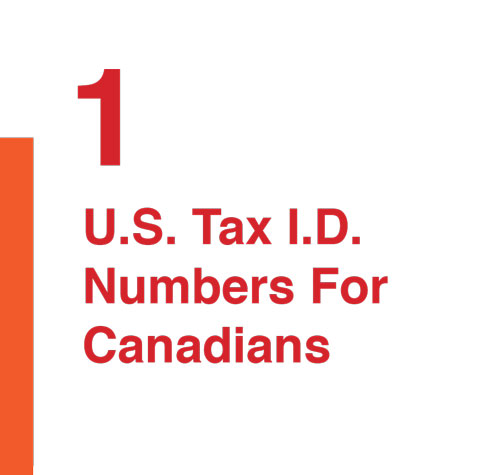
Are you curious about applying for an Individual Taxpayer Identification Number? Keep reading to find out what an ITIN is and how you can apply for one. Please note, this number is not a replacement for the Social Security Number (SSN).
What is an ITIN?
An Individual Taxpayer Identification Number (ITIN) is a number that is assigned to non-resident aliens of the U.S. who earn income in the U.S. This number is not a replacement for the Social Security Number (SSN) and does not grant any residency status in the U.S. (unlike a green card or work visa). There are new requirements for Canadians obtaining an ITIN.
Can applying for a U.S. Tax ID Number help with taxes?
As a Canadian earning income in ITIN provides several key benefits. These include:
- Lower withholding taxes on U.S. income.
- Claiming foreign tax credits on your Canadian tax return for U.S. taxes paid
- Reducing the chance of double taxation


How can Canadians get a tax identification number?
In order to properly apply for your ITIN, you must prepare Form W-7 and present proof of residence in Canada. The IRS streamlined the number of documents it accepts as proof of identity and foreign status to obtain an ITIN. There are 13 acceptable documents.
As a cross-border tax specialist operating in Mississauga, we can help you with:
- Getting a tax identification number
- Co-ordinate your ITIN application to minimize delays
- Identifying withholding tax requirements in the U.S. and opportunities to minimize these taxes.
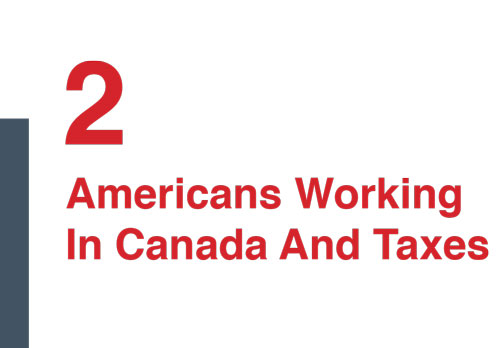
Consider the major tax consequences that will directly affect you! Here are 7 seven major tax implications that Americans working in Canada should watch out for.
1. Non-Resident versus Resident
Canadian residents are liable for tax on their worldwide income. Being a non-resident will limit your Canadian tax exposure as opposed to being a resident of Canada.
2. The 183 Day Rule Deemed Resident
The Canada – U.S. Tax Treaty can provide tax relief, because it overrides the 183 day rule. Within this treaty there are rules surrounding your residency.
3. You must file a Canadian income tax return
If you are a US citizen working in Canada, you still have to file a Canadian income tax return by April 30th. Employment income earned in Canada from January 1st, 2018 to December 31st, 2018 must be reported on your Canadian income tax return.
4. 3 tax filing requirements for US citizens working in Canada
1)T4 Slip from Employer
2)Taxes if did not Receive a W2 Slip
3)Double Taxation
5. Foreign tax credit
As a U.S. citizen or a green card holder, you


are required to file a U.S. personal income tax return and report and pay tax on your worldwide income. You must also file a Canadian tax return and pay tax on the income earned in Canada.
6. Social security taxes
If you work in the US, you are probably making contributions to your 401K and are paying social security taxes. Similarly when working in Canada, you will also have to contribute to the Canada Pension Plan (CPP) and to the Employment Insurance Plan (EI).
7. Foreign assets in access of $100 000
If you are a Canadian resident for tax purposes, you will be required to disclose all of your foreign assets having a total cost of more than $100,000. If you fail to disclose your foreign assets, you will be subject to significant penalties.
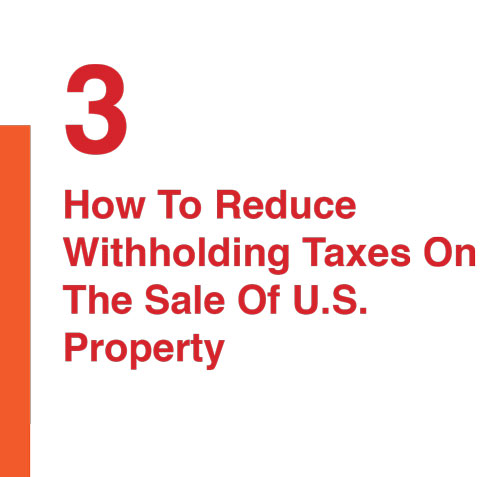
Are you selling or thinking about selling U.S. real estate? Read further to find out how Canadian sellers can reduce withholding taxes on the sale of U.S. property.
When a non-resident of the US sells US real estate, the title company must hold-back 15% of the sales proceeds. This is in accordance with the Foreign Investment in Real Property Tax Act (FIRPTA). However, if the buyer intends to use the property as a personal residence and the selling price is less than $300,000, then no taxes will be withheld from the sale.
Practical Example
Let’s take the example of Bustin Bieber, a Canadian tax resident who is selling his vacation property in Orlando Florida for $1,000,000. A withholding tax of 15% or $150,000 will apply to this sale. Bustin purchased the property in 2007 for $900,000.


Bustin would like to reduce the taxes to be withheld. He can do this by completing form 8288-B, Application for Withholding Certificate. (Please see video for full explanation).
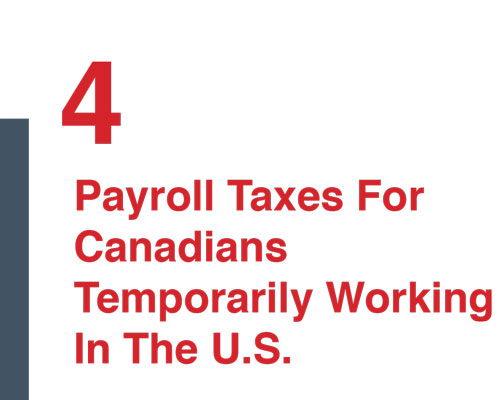
Are you a Canadian planning on temporarily working in the United States and are worried about how your payroll will be taxed? Learn about a strategy that will help you prevent double taxation and save your hard earned money along the way.
Let’s look at an example:
Vanessa works for a Canadian company in Ontario. The company is sending Vanessa to temporarily work for a client in Florida. Vanessa will divide her year of work by spending 8 months working in Canada and 4 months working in the U.S.
The problem that Vanessa now faces is how her payroll obligations will be handled as a Canadian who is temporarily working in the U.S. She wants to know exactly how she will be taxed.
Does Vanessa have to pay both Canadian and U.S. taxes?
First, we have to look at the tax treaty between Canada and the U.S. The treaty states that employment services are taxable in the country where the employee physically works.
Since Vanessa physically works in both Canada and the U.S. this year, she has to comply with both her regular Canadian


payroll taxes as well as the foreign U.S. taxes. This means deductions to her income will be doubled: her income will be taxed once in Canada and then again in the U.S.
How can Vanessa prevent double taxation?
Vanessa decides to complete form T1213:
request to reduce tax deductions at source.
By completing form T1213, Vanessa’s
Canadian payroll taxes are reduced by
approximately the same amount that her
American payroll was taxed. This prevents
and/or reduces the double taxation!
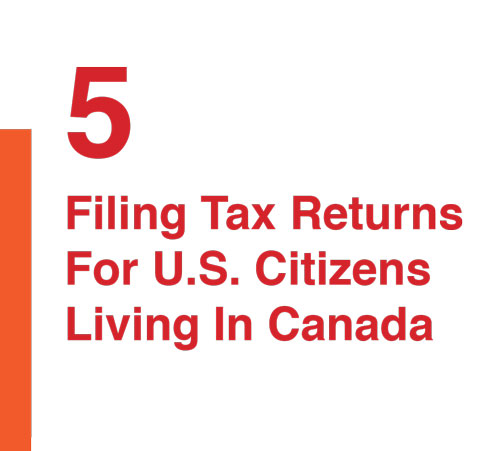
Over 1 million US citizens are living in Canada. Yet, many of them are unaware of their tax filing obligations. Read more to learn about what you should do so that you will never have to miss a tax filing deadline again.
US Personal Tax Return – Form 1040
As a US citizen you must file a US Personal Tax Return, form 1040, by April 15 of each year, even if you don’t have any US income. On this return, you must report and pay US income taxes on your worldwide income.
FBAR
If you have bank or financial accounts outside of the US with a total combined value of $10,000 or more at any point in time during the year, then you must report these accounts on a special information return called the FBAR.
Foreign Tax Credit
Without foreign tax credits, you would be double taxed as a US citizen working and living in Canada. You would first pay tax to the Canada Revenue Agency on your salary and then again to the IRS upon filing your US Personal Tax Return.


Registered Education Saving Plan
If you contributed to a RESP for your child, you must file two forms each year with the IRS – Form 3520, due on the same date as your US Personal Tax Return is, and Form 3520-A which is due on March 15.
Canadian Personal Tax Return
Your Canadian personal tax return, form T1, is due on April 30 of each year. As a resident of Canada, you are liable for Canadian income taxes on your worldwide income, which must be reported on your T1 return.
So Here’s the Tip:
Remember to file your US Personal Tax Return each year with the IRS, even if you are living outside the US. Complete the FBAR for foreign bank and financial accounts that you own. Claim foreign tax credits to avoid double taxation. And finally, if you contributed to a RESP, complete and send forms 3520 and 3520-A to the IRS.
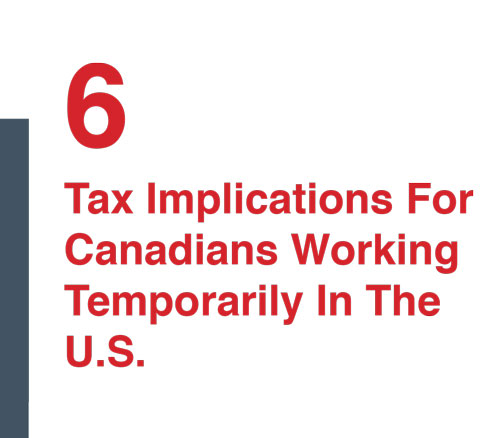
Are you a Canadian who has a temporary work assignment in the United States? Keep reading to be aware of the relevant tax issues, including how to avoid double taxation.
Assume that you remain a tax resident of Canada while working temporarily in the US, because your permanent home is still in Canada, and you have many ties to Canada including your family, credit cards, bank accounts, driver’s license, health benefits and so on.
As a resident of Canada, you will continue to pay Canadian taxes on your worldwide income. This includes employment income earned in the US.
In addition to paying Canadian taxes on your worldwide income, you must also file a Non- Resident US Tax Return, called a 1040NR. On this tax return, you will report your American earnings only and pay US federal and state taxes on those earnings to the IRS. Fortunately, the taxes paid to the IRS will be credited to you on your Canadian personal tax return, in the form of a Foreign Tax Credit. Through the Foreign Tax Credit mechanism, you avoid paying double tax.


The most common way employers report your US earnings is on a Wage and Tax Statement, called a W2.
Keep track of the number of days spent in the US. If the total days is more than 182, then you will have to complete a special form to prove to the IRS that you are a non-resident of the US and a resident of Canada, because your ties are strongest with Canada.

What are the tax implications for sending US Citizens to Work in Canada? This is a loaded question and the cross border tax implications are complex.
1) According to regulation 102 of the Canadian income tax act, an American employer that sends US employees to work in Canada must withhold Canadian payroll taxes. Canadian payroll taxes are comprised of Canadian income taxes, CPP, and employment insurance premiums.
2) Canadian payroll taxes are only levied on Canadian employment services physically performed in Canada. As an employer it is important to keep track of the employee’s days spent working in Canada as this will affect the amount of Canadian payroll taxes to be deducted from their pay cheques.
3) As a foreign employer, you must register for a Canadian business number and issue Canadian employment slips, called T4s, to your employees each year in Canada. T4s are very similar to the American W2 slips.
4) A cash flow problem will almost certainly arise for your employees if you don’t take certain actions. The problem arises because payroll taxes are being deducted twice. First


for Canadian payroll taxes, then again for US payroll taxes. This leads for a very angry employee, with little after tax cash from their pay cheques. In order to reduce the US payroll taxes and alleviate this double tax problem, complete Form W4.
5) Your employees are probably already resentful for being shipped to the cold Canadian north, but what’s even worse is that they have to contribute to the US social security system and the CPP. To avoid paying CPP Premiums, you should obtain a certificate of coverage from the social security administration.
Quick Tip:
Before sending your employees to work in Canada, consider the tax implications from the US and Canadian perspective, as well as consult with a cross border tax accountant to help you.
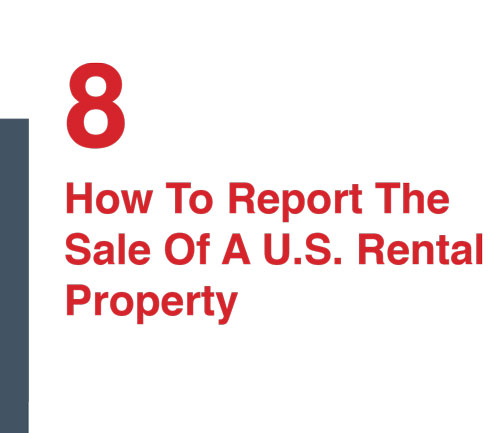
Are you planning to sell a rental property in the U.S.? If yes, learn how to report the sale of your rental property on a U.S. Tax Return now.
Example:
Justin Trupou is a Canadian resident who owns a U.S. rental property. Here are a few important details:
- He purchased the property in 2016 for $100,000 USD.
- He sold the property on December 31, 2018 for $130,000 USD.
- He paid a commission of $2,000 to his real estate agent for selling the property.
As of the end of 2018, he has claimed total depreciation of $10,606 since he purchased the property.
Step 1 Justin has to complete form 4797, Sale of Business Property. On page 1 of this form, he should write his name at the top and his US tax identification number.
Step 2 Next, Justin has to calculate the Adjusted Basis or ‘tax cost’ of his rental property.


The difference between the selling price of $130,000 and the Adjusted Basis of $91,394 gives rise to a capital gain of $38,606.
Remember to report this amount on lines 6, 7, 24, 30 and 32 of Form 4797 as well.
Step 3 Now, Justin has to complete Schedule D. But first, you need to understand the difference between long term and short term capital gains.
Capital gains can either be treated as long term or short term. Long term gains arise from a property that is owned for at least 1 year prior to sale.
Step 4 The final step is to report the capital gain of $38,606 on line 14 of Justin’s US Tax Return. This capital gain will be added to Justin’s total income.

Are you a Canadian investor in US real estate? If yes, then this video is meant for you. I will show you how to prepare a 1040- NR Tax Return for your US rental property.
This video is part one of a two part series. In part 1, I will cover form 1040-NR and in part 2 I will review schedule E and form 4562.
Example:
Let’s look at the example of Mr. Justin Trupou, a Canadian resident who lives in Ottawa, Ontario. He is married to a Canadian, with one dependent child who is 17 years old. He is the sole owner of a rental property in Orlando, Florida.
Step 1 – Complete the Identification Area of form 1040-NR
Step 2 – Complete your Filing Status
Step 3 – Claim Exemptions
Step 4 – Report Rental Profit


Step 5 – Calculate the Tax and Credits
Step 6 – Enter Payments Made
Step 7 – Determine Amount Payable or Refundable
Step 8 – Complete Page 5, Other Information
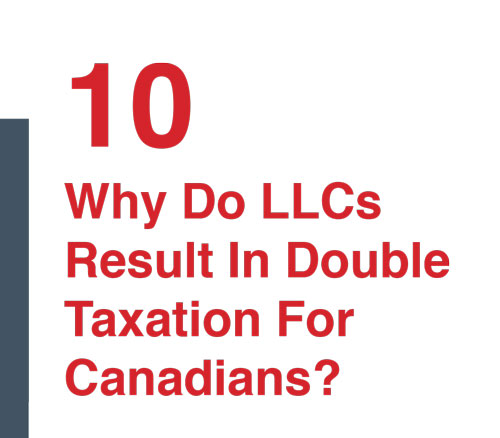
If you are a Canadian interested in making a U.S. property investment, using an LLC will ultimately result in double taxation for you.
How is a Limited Liability Company Taxed? Under the U.S. taxation system, an LLC may be treated as:
1) Disregarded Entity
An LLC with a single member is classified by default as a disregarded entity by the IRS. The IRS does not consider the LLC as being separate from its owner and, as a result, the LLC’s income is reported on the owner’s personal tax return.
2) Partnership
An LLC with more than one member is by default classified as a partnership by the IRS. Form 1065 (U.S. Return of Partnership Income) should be filed, and each owner should show his or her share of the partnership income.
3) Corporation
A unique feature of an LLC is that it can elect the manner in which it is taxed. Thus, an LLC which, by default, is either a disregarded entity or partnership can choose to be treated as a corporation by filing Form 8832 (Entity


Classification Election).
Why are LLC’s a Major Headache for Canadians?
If you are a Canadian resident who owns U.S. property through an LLC, the IRS will first tax any income you earn from the property. On the U.S. side, you will elect to treat the LLC as a disregarded entity, partnership or corporation.
What is the Best Alternative for Canadians?
Canadians should not be deterred from investing in the U.S. as there are ways to avoid double taxation, one being purchasing property by setting up a U.S. Limited Partnership (USLP).
About the Author

Allan Madan is a CPA, CA, and international tax expert. He is a graduate of the University of Waterloo where he earned a Masters Degree in accounting. He enjoys working with business owners, entrepreneurs and individuals. Allan has over 10 years of experience in public accounting. Prior to founding Madan Chartered Accountant in Mississauga, he worked for the Deloitte firm where he was the International Tax Manager. He has completed Parts 1 and 2 of the Canadian In Depth Tax Course, which is the most comprehensive tax training in Canada.
About the Company

At Madan Chartered Accountant, we know how important the experience is. We also know how critical it is to have someone in your corner that knows your unique situation. Your taxes are important to us, because they are important to you. Our knowledgeable and friendly staff will always take the time to go the extra mile. Among all the accounting firms in Mississuga, we’re special. Our unique size enables us to answer the most complex of problems, yet provide personal attention to all our clients.
Contact Us:
Address:
145 Traders Boulevard East, Unit 20
Mississauga, ON L4Z 3L3
Phone: (905) 268-0150
© 2018 Madan Chartered Accountant Professional Corporation. All Rights Reserved.
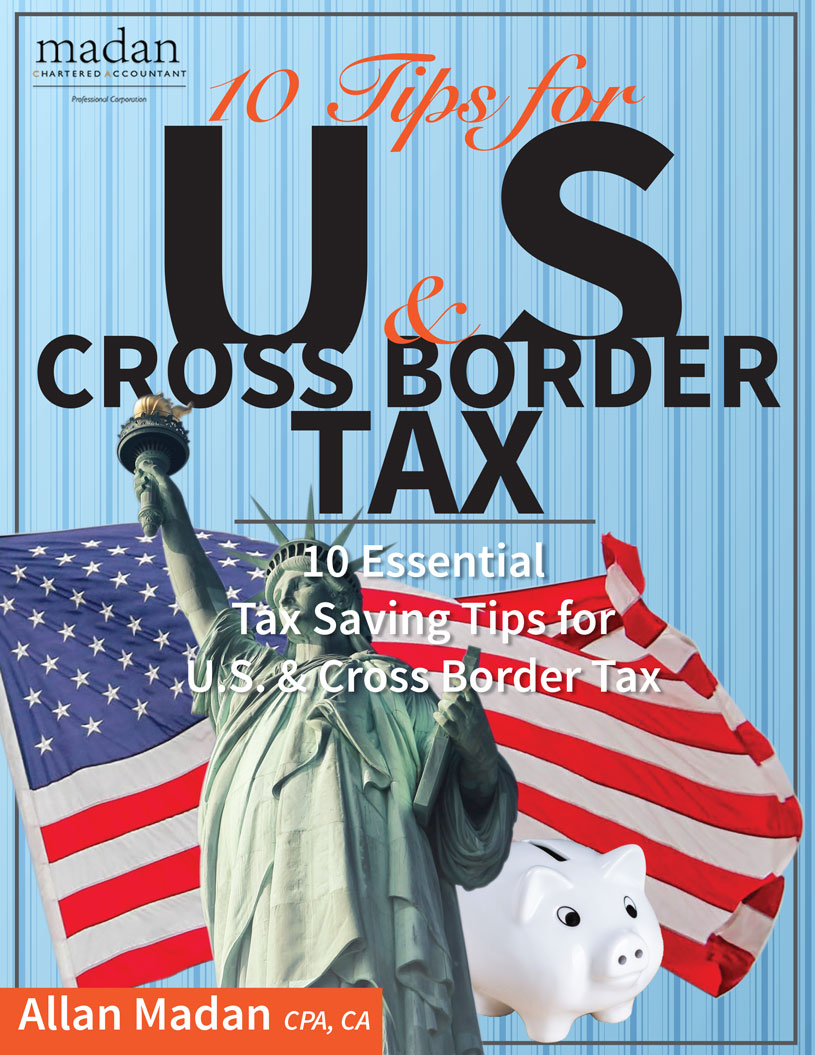
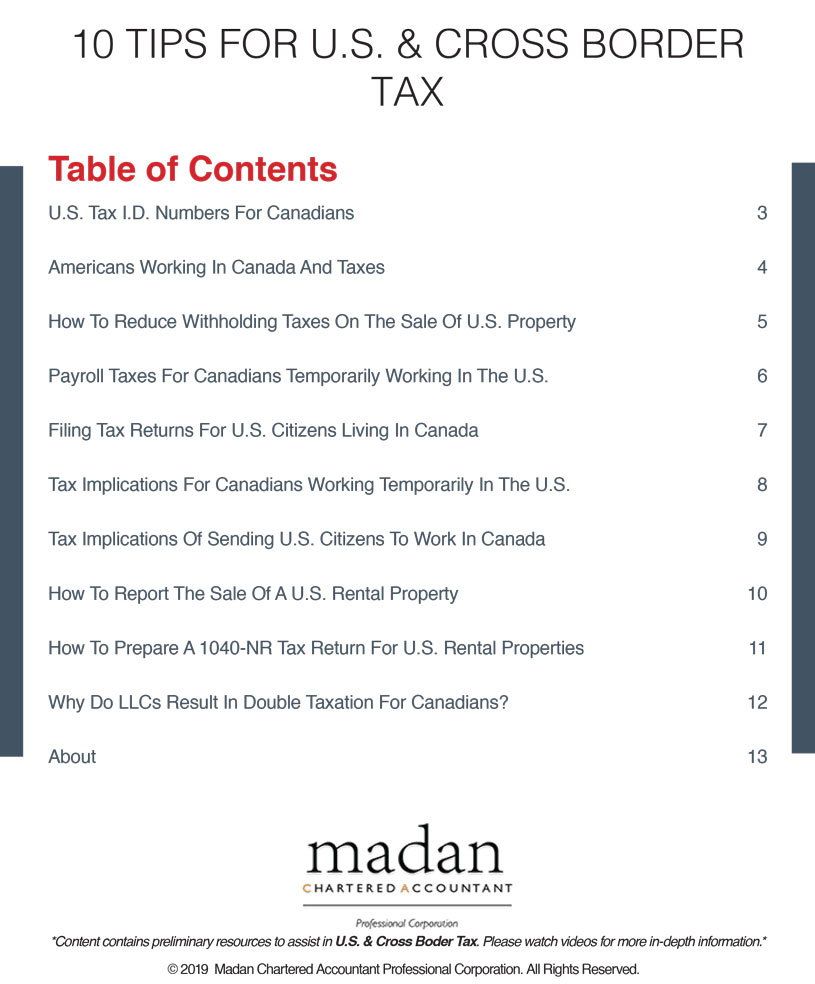

SOCIAL CONNECT